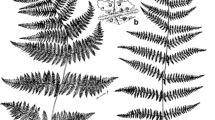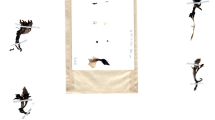Abstract
A taxonomic, morphological, ecological, and molecular study of three interesting Morchella species, Morchella tridentina, M. rufobrunnea, and M. kakiicolor, is presented, based on observations and analyses of collections from Cyprus and Spain. The nomenclatural and taxonomic problems associated with the name M. tridentina and its synonyms, M. elatoides and M. frustrata, are discussed. A neotype is designated for M. quercus-ilicis to replace the lost holotype, and its synonymy with M. tridentina is proposed. The holotype of M. quercus-ilicis f. kakiicolor is confirmed as genetically distinct from the neotype of M. quercus-ilicis, and a new combination, M. kakiicolor (Clowez & L. Romero) comb. nov. is introduced. The presence of M. rufobrunnea in Europe is confirmed with molecular data for the first time. Updated descriptions of all three species, including new morphological and ecological data, as well as detailed illustrations are provided.







Similar content being viewed by others
References
Barseghyan GS, Kosakyan A, Isikhuemhe OS, Didukh M, Wasser SP (2012) Phylogenetic analysis within genera Morchella (Ascomycota, Pezizales) and Macrolepiota (Basidiomycota, Agaricales) inferred from rDNA ITS and EF-1a Sequences. In: Misra JK, Tewari JP, Deshmukh SK (eds) Systematics and evolution of fungi. Science Publishers, USA, 422pp
Baynes M, Newcombe G, Dixon L, Castlebury L, O'Donnell K (2012) A novel plant-fungal mutualism associated with fire. Fungal Biol 116(1):133–144
Boudier E (1897) Révision analytique des morilles de France. Bull Soc Mycol Fr 13:130–150
Boudier E (1909) Icones mycologicae ou iconographie des champignons de France principalement discomycètes avec texte descriptif. Tome II, pl. 194–421. Librairie des Sciences Naturelles, Paris
Bresadola G (1898) Fungi Tridentini 2 (11–13): 47–81, pl. 151–195
Buscot F, Roux J (1987) Association between living roots and ascocarps of Morchella rotunda. Trans Br Mycol Soc 89(2):249–252
Buscot F (1992) Mycorrhizal succession and morel biology. In: Read DJ, Lewis DH, Fitter AH, Alexander IJ (eds) Mycorrhizas in ecosystems. CAB International, Wallingford, pp 220–224
Clowez P (2012) ('2010') Les morilles: Une nouvelle approche mondiale du genre Morchella. Bull Trimest Soc Mycol Fr 126(3–4):199–376
Clowez P, Alvarado P, Becerra M, Bilbao T, Moreau P-A (2014) Morchella fluvialis sp. nov. (Ascomycota, Pezizales): a new but widespread morel in Spain. Bol Soc Micol Madr 38(2):251–260
Dahlstrom JL, Smith JE, Weber NS (2000) Mycorrhiza-like interaction by Morchella with species of the Pinaceae in pure culture synthesis. Mycorrhiza 9(5):279–285
Dennis RWG (1978) Bristish Ascomycètes. Ed. Cramer, Vaduz, 585 p
Dissing H (2000) Pezizales Bessey. In: Hansen L, Knudsen H (eds) Nordic Macromycetes. Vol. 1. Ascomycetes. Nordsvamp, Copenhagen, pp 55–127
Du X-H, Zhao Q, O’Donnell K, Rooney AP, Yang ZL (2012a) Multigene molecular phylogenetics reveals true morels (Morchella) are especially species-rich in China. Fungal Genet Biol 49:455–469
Du X-H, Zhao Q, Yang ZL, Hansen K, Taşkın H, Büyükalaca S, Dewsbury D, Moncalvo J-M, Douhan GW, Robert VARG, Crous PW, Rehner SA, Rooney AP, Sink S, O’Donnell K (2012b) How well do ITS rDNA sequences differentiate species of true morels (Morchella)? Mycologia 104:1351–1368
Elliott TF, Bougher NL, O’Donnell K, Trappe JM (2014) Morchella australiana sp. nov., an apparent Australian endemic from New South Wales and Victoria. Mycologia 106:113–118
Gardes M, Bruns TD (1993) ITS primers with enhanced specificity for basidiomycetes—application to the identification of mycorrhizae and rusts. Mol Ecol 2:113–118
Guzmán G, Tapia F (1998) The known morels in Mexico, a description of a new blushing species, Morchella rufobrunnea and new data on M. guatemalensis. Mycologia 90:705–714
Isiloglu M, Alli H, Spooner BM, Solak MH (2010) Morchella anatolica (Ascomycota), a new species from southwestern Anatolia, Turkey. Mycologia 102(2):455–468
Jacquetant E (1984) Les Morilles, Paris, La Bibliothèque des Arts. 114p
Kanwal HK, Acharya K, Ramesh G, Reddy MS (2011) Molecular characterization of Morchella species from the western Himalayan region of India. Curr Microbiol 62:1245–1252
Kellner H, Renker C, Buscot F (2005) Species diversity within the Morchella esculenta group in Germany and France. Org Divers Evol 5:101–107
Kuo M, Dewsbury DR, O’Donnell K, Carter MC, Rehner SA, Moore JD, Moncalvo J-M, Canfield SA, Stephenson SL, Methven AS, Volk TJ (2012) Taxonomic revision of true morels (Morchella) in Canada and the United States. Mycologia 104:1159–1177
Kuo M (2008) Morchella tomentosa, a new species from western North America and notes on M. rufobrunnea. Mycotaxon 105:441–446
Loizides M (2011) Morchella rufobrunnea, Η μορχέλλα της πόλης. Μυκητολόγος 5:10–13
Loizides M (2013) Μορχέλλες της Κύπρου. Μυκητολόγος 8:24–27
Loizides M, Kyriakou T, Tziakouris A (2011) Edible & Toxic Fungi of Cyprus. Published by the authors, pp. 228–229
Masaphy S, Zabari L, Goldberg D (2009) New long-season ecotype of Morchella rufobrunnea from northern Israel. Micol Apl Int 21(2):45–55
Matheny PB, Wang Z, Binder M, Curtis JM, Lim YW, Nilsson RH, Hughes KW, Hofstetter V, Ammirati JF, Schoch CL, Langer E, Langer G, McLaughlin DJ,Wilson AW, Frøslev T, Ge ZW, Kerrigan RW, Slot JC, Yang ZL, Baroni TJ, Fischer M, Hosaka K, Matsuura K, Seidl MT, Vauras J, Hibbett DS (2007) Contributions of rpb2 and tef1 to the phylogeny of mushrooms and allies (Basidiomycota, Fungi). Mol Phylogenet Evol 43(2):430–451
Moreau P-A, Hériveau P, Bourgade V, Bellanger J-M, Courtecuisse R, Fons F, Rapior S (2011) Redécouverte et typification des champignons de la région de Montpellier illustrés par Michel-Félix Dunal et Alire Raffeneau-Delile. Cryptog Mycol 32:255–276
Moreau P-A, Bellanger J-M, Clowez P, Courtecuisse R, Hansen K, Knudsen H, O’Donnell K, Richard F (2014) Proposal to conserve the name Morchella semilibera against Phallus crassipes, P. gigas and P. undosus (Ascomycota). Taxon 63(3):677–678
Moser M (1963) Ascomyceten (Schlauchpilze). In: Gams H, Kleine Kryptogamenflora von Mitteleuropa IIb. Jena
Nylander JAA (2004) MrModeltest 2. Evolutionary Biology Centre, Uppsala University, Uppsala
O’ Donnell K, Rooney AP, Mills GL, Kuo M, Weber NS, Rehnere SA (2011) Phylogeny and historical biogeography of true morels (Morchella) reveals an early Cretaceous origin and high continental endemism and provincialism in the Holarctic. Fungal Genet Biol 48:252–265
Pildain MB, Visnovsky SB, Barroetavena C (2014) Phylogenetic diversity of true morels (Morchella), the main edible non-timber product from native Patagonian forests of Argentina. Fungal Biol 118:755–763
Pion M, Spangenberg JE, Simon A, Bindschedler S, Flury C, Chatelain A, Bshary R, Job D, Junier P (2013) Bacterial farming by the fungus Morchella crassipes. Proc Biol Sci 280(1773):20132242. doi:10.1098/rspb.2013.2242
Richard F, Bellanger J-M, Clowez P, Hansen K, O’Donnell K, Urban A, Sauve M, Courtecuisse R, Moreau P-A (2014) True morels (Morchella, Pezizales) of Europe and North America: Evolutionary relationships inferred from multilocus data and a unified taxonomy. Mycologia, in press (preliminary version on line), doi:10.3852/14-166
Röllin O, Anthoine A (2001) Les morilles noires du Chablais savoyard genre Morchella, section Distantes. 1 - Remarques préliminaires et présentation de Morchella elata Fr. et Morchella tridentina Bres. Bull Trimest Féd Mycol Dauphiné-Savoie 161:7–12
Ronquist F, Huelsenbeck JP (2003) MrBayes 3: Bayesian phylogenetic inference under mixed models. Bioinformatics 19:1572–1574
Stefani FO, Sokolski S, Wurtz TL, Piche Y, Hamelin RC, Fortin JA, Berube JA (2010) Morchella tomentosa: a unique belowground structure and a new clade of morels. Mycologia 102(5):1082–1088
Swofford DL (2001) PAUP*: phylogenetic analysis using parsimony (and other methods). Version 4.0b10. Sinauer Associates, Sunderland
Tamura K, Peterson D, Peterson N, Stecher G, Nei M, Kumar S (2011) MEGA5: molecular evolutionary genetics analysis using maximum likelihood, evolutionary distance, and maximum parsimony methods. Mol Biol Evol 28(10):2731–2739
Taşkın H, Büyükalaca S, Hüseyin H, Rehner S, O’Donnel K (2010) A multigene molecular phylogenetic assessment of true morels (Morchella). Fungal Genet Biol 47:672–682
Taşkın H, Büyükalaca S, Hansen K, O’Donnell K (2012) Multilocus phylogenetic analysis of true morels (Morchella) reveals high levels of endemics in Turkey relative to other regions of Europe. Mycologia 104:446–461. doi:10.3852/11-180
Tedersoo L, May TW, Smith ME (2010) Ectomycorrhizal lifestyle in fungi: global diversity, distribution, and evolution of phylogenetic lineages. Mycorrhiza 20(4):217–263
White TJ, Bruns T, Lee S, Taylor JW (1990) Amplification and direct sequencing of fungal ribosomal RNA genes for phylogenetics. In: Innis MA, Gelfand DH, Sninsky JJ, White TJ (eds) PCR protocols: a guide to methods and applications. Academic Press Inc, New York, pp 315–322
Wood M, Stevens F (1999–2013) California Fungi — Morchella rufobrunnea. In: Mycoweb. The Fungi of California. Available on Internet (accessed Oct 2014): <http://www.mykoweb.com/CAF/species/Morchella_rufobrunnea.html>
Acknowledgments
We would like to thank Kerry O’ Donnell and Michael Kuo for confirming the first identification of M. rufobrunnea from Cyprus in 2009. We are most grateful to Karen Hansen (Swedish Museum of Natural History, Stockholm) for all precisions about Bresadola’s original collections and to Jean-Michel Bellanger, Franck Richard and Mathieu Sauve (CEFE-CNRS, Montpellier), who are greatly acknowledged for generating most of the sequences cited in this study, for preliminary molecular analyses and for their friendly support. We also thank Carlos Monedero, Luis Ballester, Manuel Becerra Parra, and Tomás Illescas for kindly providing us with specimens and images for a number of the species studied and Ron Pastorino for granting us permission to use his image of M. frustrata. Last but not least, we are grateful to Sian & Sophia Loizides for collecting the first specimen of M. rufobrunnea in Cyprus and kindly bringing it to our attention, and to Angelos Papadimitriou for his helpful linguistic suggestions.
Author information
Authors and Affiliations
Corresponding author
Rights and permissions
About this article
Cite this article
Loizides, M., Alvarado, P., Clowez, P. et al. Morchella tridentina, M. rufobrunnea, and M. kakiicolor: a study of three poorly known Mediterranean morels, with nomenclatural updates in section Distantes . Mycol Progress 14, 13 (2015). https://doi.org/10.1007/s11557-015-1030-6
Received:
Revised:
Accepted:
Published:
DOI: https://doi.org/10.1007/s11557-015-1030-6




